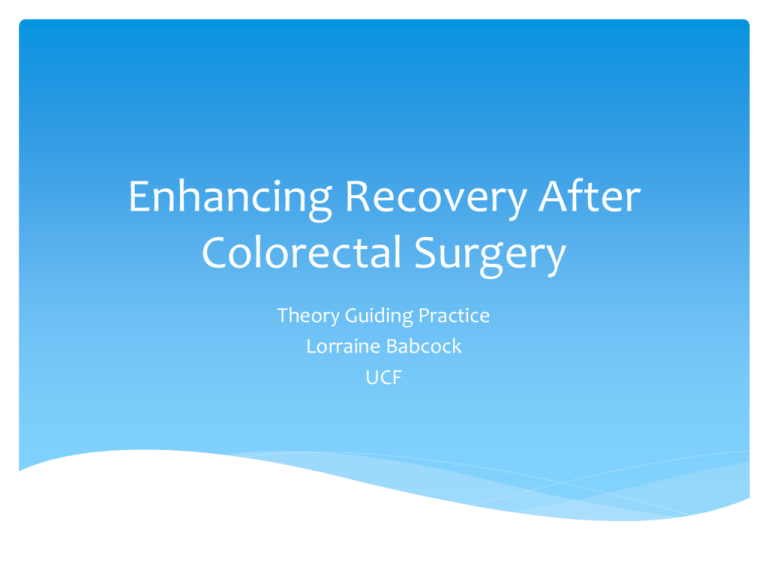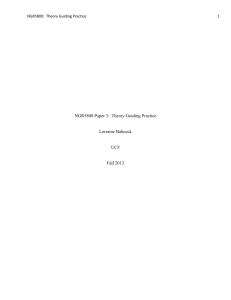Enhancing Recovery After Colorectal Surgery
advertisement

Enhancing Recovery After Colorectal Surgery Theory Guiding Practice Lorraine Babcock UCF Background The cognitive adult patient s/p colorectal surgery (with a new stoma) present multifaceted challenges for nursing Enhanced recovery programs designed to reduce recovery time are now in use High stress & anxiety hinder retention of patient education, often delaying discharge The nurse must develop a plan of care with emphasis on coping strategies & education Surgeons & patients rely on nursing for positive outcomes Statement of the Problem Adult stoma patients with normal intellect experience ineffective health maintenance related to impaired knowledge regarding integration of stoma care into their lifestyle The essence of this problem is motivation & changing behavior Significance of the Problem Inflammatory bowel disease (IBD) includes Crohn’s & ulcerative colitis IBD causes pain, altered elimination, fatigue, & malnutrition IBD affects as many as 1.4 million people in the US Over 100,000 hospitalizations per year are due to IBD IBD has an overall healthcare cost of over $1.7 billion annually Patients usually require healthcare throughout their lifetime There is no medical cure, only symptom management & surgical intervention (when medicine fails) Focus on education & coping is beneficial for patient recovery Specific Aims Nursing has an opportunity to help improve patient outcomes by applying a middle range theory to ready the patient for discharge The Theory of Self-Efficacy will address the core problems of motivation & changing behaviors The goal is to use the critical elements to design successful plans of care for the stoma patient Shared decision making Teamwork Communication The patient, family, providers, & nursing should be involved Theory of Self-Efficacy Definition of self-efficacy: the individual’s own recognition of his or her ability to take action Theory of Self-Efficacy is based on the social cognitive theory Two vital concepts of the theory Self-efficacy expectations Outcome expectations The environment & interactions with others are also influential The individual must believe they are capable of causing a certain outcome Application of Theory to Practice To apply the theory, the nurse should focus on each of the theory’s informational sources Enactive attainment Ex: set goal for patient to return demonstrate self-care of stoma by postoperative day 2 Vicarious experience Ex: visualize others performing the desired behavior Verbal persuasion Ex: nursing & providers give verbal encouragement & support the patient’s efforts Physiological feedback during a behavior Ex: maintain pain at an acceptable level through use of relaxation techniques & non-opioid medications Summary and Conclusions Adult stoma patients with normal intellect often have difficulty incorporating self-care into their lifestyle after discharge Stress & anxiety may hinder knowledge retention Problems with ineffective coping, motivation, & changing behavior are common Enhanced recovery discharge objectives are often hard to meet without focused nursing interventions Through application of the Theory of Self-Efficacy, the nurse can effect positive outcomes, where the patient is motivated & able to change behaviors References Aasa, A., Hovbäck , M., & Berterö, C. M. (2013, June). The importance of preoperative information for patient participation in colorectal surgery care. Journal of Clinical Nursing, 22(11-12), 1604-1612. Ackley, B. J., & Ladwig, G. B. (2006). Nursing Diagnosis Handbook (8th ed.). St. Louis, Missouri: Mosby Elsevier. Allison, M., Lindsay, J., Gould, D., & Kelly, D. (2013, November). Surgery in young adults with Inflammatory Bowel Disease: A narrative account. International Journal of Nursing Studies, 50(11), 1566-1575. Babcock, L. (2013, October 25). NGR5800: Paper 2 Analysis of a Nursing Problem. Borkowski, S. (1998). Pediatric stomas, tubes, and appliances. The Pediatric Clinics of North America, 45(6), 1419-1435. CDC. (2012). Inflammatory Bowel Disease. Retrieved from Centers for Disease Control and Prevention: http://www.cdc.gov/ibd/ Danielson, A. K., Soerensen, E. K., Burcharth, K., & Rosenberg, J. (2013, January). Impact of a temporary stoma on patients’ everyday lives: feelings of. Journal of Clinical Nursing, 22(9-10), 1343-1352. Krouse, R. S., Grant, M., Rawl, S. M., Mohler, M. J., Baldwin, C. M., Coons, S. J., et al. (2009, March). Coping and acceptance: The greatest challenge for veterans with intestinal stomas. Journal of Psychosomatic Research, 66(3), 227-233. Mayo Clinic. (1998-2013). Inflammatory bowel disease. Retrieved from Mayo Foundation for Medical Education and Research: http://www.mayoclinic.com/health/inflammatory-bowel-disease/DS01195/DSECTION=symptoms McEwen, M., & Wills, E. M. (2011). Theoretical Basis for Nursing (3rd ed.). Philadelphia, PA: Lippincott Williams & Wilkins. Peter, D., & Robinson, P. (2011, October). Teach-back technique must be taught. Patient Education Management, 18(10), 112-113. Readding, L. A. (2005, September). Hospital to home: smoothing the journey for the new ostomist. British Journal of Nursing, 14(16), S17-S20. Singh, S., Butow, P., Charles, M., & Tattersall, M. H. (2010, September). Shared decision making in oncology: assessing oncologist behaviour in consultations in which adjuvent therapy is considered after primary surgical treatment. Health Expectations. Smith, M. J., & Liehr, P. R. (2014). Middle Range Theory for Nursing (3rd ed.). New York: Springer Publishing Company. Trunnell, E. P. (1996, January). Mindfulness and people with stomas. Journal of Wound, Ostomy and Continence Nursing, 23(1), 38-45. Wong, E. M.-L., Chan, S. W.-C., & Chair, S.-Y. (2010, May). Effectiveness of an educational intervention on levels of pain, anxiety, and self-efficacy for patients with musculoskeletal trauma. Journal of Advanced Nursing.






